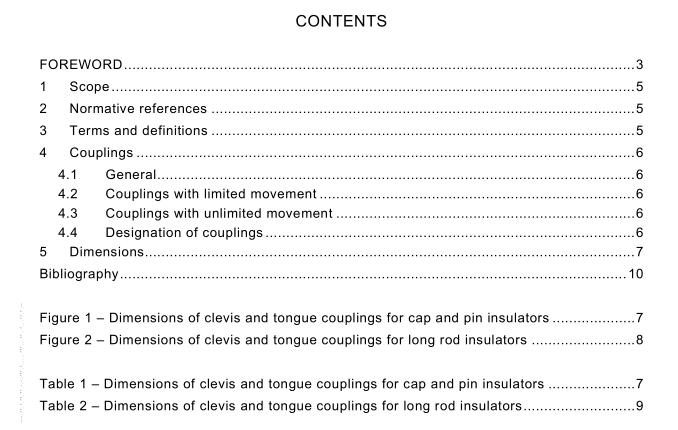IEC 60471 pdf – Clevis and tongue couplings of string insulator units – Dimensions

IEC 60471 pdf – Clevis and tongue couplings of string insulator units – Dimensions
3.3
tongue
male part of a clevis and tongue coupling with a tongue-shaped extremity which fits into theU-shaped opening of the clevis and which contains a hole through which the coupling pin maybe passed
3.4
coupling pin
rigid pin which passes through the holes in the clevis and tongue to couple them together
Note 1 to entry: On one end , the coupling pin has a stud head and on the other a security device (e.g. saplit pin) ispllaced to hold the pin in its place.
4couplings
4.1General
Two coupling systems are recommended:- Couplings with limited movement;- Couplings with unlimited movement.4.2couplings with limited movement
Couplings according to Figure 1, and Table 1, for which a limited movement of the tongue inthe clevis needs to be assured.
This type of coupling is used for cap and pin insulators to ensure that no contact is possiblebetween the insulating parts of two consecutive insulators. A rectangular shape isrecommended for the tongue.
These couplings are designated by the nominal diameter,expressed in millimetres,of thecoupling pin followed by the letter c.
4.3couplings with unlimited movement
Couplings according to Figure 2, and Table 2, for which the movement of the tongue in theclevis is not limited.
This type of coupling is used for long rod insulators.
These couplings are designated by the nominal diameter,expressed in millimetres,of thecoupling pin followed by the letter L.
4.4Designation of couplings
Clevis and tongue coupling are designated by the nominal diameter,expressed in millimetres,of the coupling pin which connects the clevis and tongue.A designated coupling is defined bythe dimensions of the clevis,of the tongue and of the coupling pin.
The Figure 1 and Figure 2 giving the diameter of the coupling pin is followed by the letter C inthe case of couplings for cap and pin insulators or by the letter L in case of long rod insulators.
Any confusion shall be avoided between the designation mentioned above referring to clevisand tongue couplings and the ball and socket couplings which are designated by nominal pindiameter which,in certain cases,may be followed by the letter A or B (see IEC 60120),Therefore, the type of coupling shall always be precisely designated.
5 Dimensions All the dimensions indicated in Table 1 and Table 2 are given in millimetres, and refer to the finished articles after surface treatment such as, for instance, galvanizing (see also Figure 1 and Figure 2). NOTE The outside dimensions of the clevis have not been fixed, since they depend on the mechanical characteristics of the material used. Therefore, the length of the coupling pin is not fixed and, unless otherwise agreed, the coupling pin shall be delivered together with the clevis. A security device shall be placed to hold the pin in its place. In the case of cap and pin insulators (see IEC 60305), the spacing of the insulators has been chosen so that there will be no difficulty in inserting the coupling pin in its place. However, for some types of cap and pin insulators with very deep rims at the lower end of the insulator close to the tongue, it may be difficult to insert the coupling pin. In such a case, it will be necessary to check that the coupling pin can be inserted.









